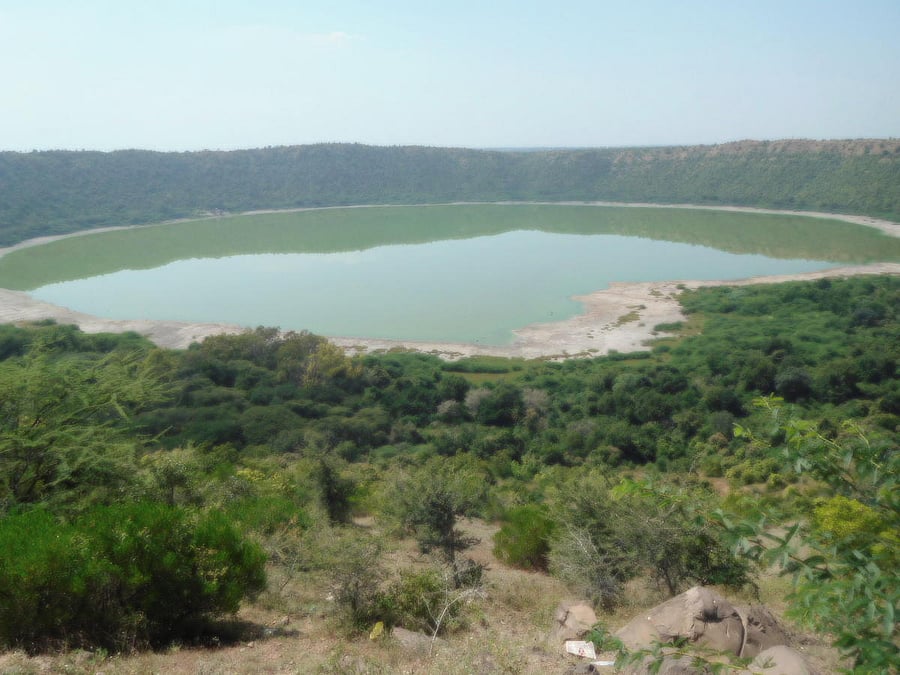
Lonar crater lake and its surroundings are huge and picturesque and are located in Buldhana district in Vidarbha region of Maharashtra. It is a sort of mystery and is like one of Maharashtra's best-kept secrets. The oval-shaped Lonar lake, located about 500 km from Mumbai, has attracted geologists, ecologists, archaeologists, naturalists, astronomers and mythologists from across the globe.
However, it has failed to attract a large number of tourists. Most of them come to nearby Aurangabad in Marathwada region to visit Ajanta and Ellora caves, Unesco World Heritage sites, but only a few take time off and make it to Lonar.
The lake was formed nearly 52,000 years ago when a meteorite slammed Deccan Plateau. The meteorite weighed two million tonnes and was travelling at an estimated speed of 90,000 kmph. It created a hole which was 150 m deep and 1.8 km wide! Scientists believe that the energy released was equivalent to a six-megaton atom bomb. Due to this bombardment, the small segments of melted rocks and glass samples were expelled around the crater rim, according to a scientific paper.
The collision led to formation of one of the largest, most unique basalt impact craters in the world. It has a mean diameter of 1.2 km and is about 137 m below the crater rim. The meteor crater rim is about 1.8 km in diameter.
The lake is the largest and only salt water lake in basaltic rock and that makes it more interesting. This crater was first discovered in 1823 by British officer J E Alexander.
The Lonar lake is notified as a National Geo-heritage Monument and experts, Geological Society of India, the University of Sagar, Physical Research Laboratory, the Smithsonian Institution, the United States Geological Survey among others have conducted extensive studies of the site over the last few decades.
"Its a unique site and is very important for researchers across various streams," says Dr Bharat Adur, veteran astronomer and founder of Akash Ganga: Centre for Astronomy (AGCA) at Badlapur in Thane district.
"We are popularising it as a tourist destination," Maharashtra Tourism Development Corporation Vijay Waghmare pointed out.
"Visitors do come here but given the potential we feel that more tourists, researchers and students should visit Lonar," says tourist guide Raju Jadhav, who is popularly known as Raju Guide.
"Lonar lake is unique in its diversity as it bears high alkalinity and salinity at the same time. It is a treasure of many extremophiles, magnetotactic bacteria as well as various algal species. The principle vegetation of the area is dry deciduous forest surrounded at the edge of alkaline lake," says Mauresh Prabhune, the secretary of Center for Citizen Science (CCS), based in Pune.
The crater lake is home to hundreds of peafowl, chinkara and gazelles, which browse among the shrubs and bushes ringing the lake. Other residents include egrets, moor hens, herons, coots, white-necked storks, lapwings, grey wagtails, grebes, black droungos, green bee-eaters, tailorbirds, magpies and robins - as well as lot of migratory birds.
Over a period of 1,500 years various kings built around 15 temples on the banks of the lake and most of them are in ruins today. The temples depicting ancient architecture at its finest levels. "Fluctuations and rapid changes in Lonar lake are harmful for the biodiversity and life forms in the lake. It is of utmost priority to perform holistic study on the changes in water levels. In order to preserve the uniqueness of Lonar lake and crater; there is a need for special policy," says Dr Yogesh Shouche, eminent microbiologist and president of the CCS.
Satellite imagery taken during the same period, showed the trend of water reduction since 2014. The percolation tank near the lake dried up during the same timeline. Also a lot of construction sites were visible in the imagery. As per information undertaken from the local citizens, along with new construction sites, the borewells were raised along the ejecta of the crater. Some of the borewells are located at a distance of less than 100 m from the crater rim. The observational study clearly states that reduction in water levels of the lake is a combined result of drying up of the percolation dam and the closure of streams in to the lake.
Teacher-activist Sudhakar T Bugdane, who is from Lonar and has written a book on the lake and has been corresponding with Indian and international institutes and the Centre and the Maharashtra government, said: "Its saline water, microbial life, algae, geomagnetism, rare mineral groups and other geo-morphological values makes it a unique site."
